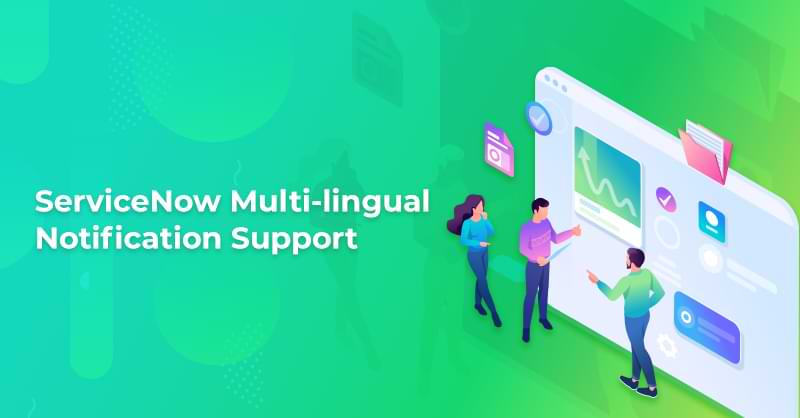ServiceNow Multi-lingual Notification Support

Written by Ashish Kumar Sahu
Technical Lead-ServiceNow
October 1, 2022
It is a known fact that nowadays most MNCs have a diverse and multilingual group of employees scattered all over the world. However, it just isn’t possible to offer round-the-clock help in every language and on every channel due to the diverse nature of the workforce.
Traditionally, translating emails was a tedious task for a developer as well as for the organization as it required time and effort. Usually, what people ended up doing is creating separate notification records for each language. That means really complex conditions to figure out what the user that the notification is aimed at, what their language preference is, and it’s completely difficult when you’re dealing with notifications that are event triggered and not condition triggered.
Pre Tokyo-Challenges with Notification Translation
Setting up notifications in various languages, you could see some “solutions” out there. For example:
- Adding a condition to the notification, validating the language of the email sender. Easy to set up and for some customers this would work fine. Though what if the sender’s language setting is not the same as the receiver’s language setting?
- Scripting the subject and message body, using gs.getMessageLang() to translate all text to match the receiver’s language setting. This works fine, though will require all text to be added as UI Messages. Also, this only works for one receiver, not when working with a watch list or a group which contains receivers with different language settings.
- Creating separate events for all receivers of the Notification, to validate the individual receiver’s language settings and send the Notification in the correct language. Works well, though the customizations needed for these are way too much.
Advantages of the ServiceNow Tokyo Release
The ServiceNow Tokyo release goes a long way to solve this with their multilingual translations. It is easy for users to send notifications in multiple languages. It reduces the efforts of writing the scripts and converting the emails into multiple languages. There are two ways provided to setup multi-lingual notifications:
Static Multi-Lingual Notification Support
You would have your normal Notification record and add a “Translated Notification” record [sys_translated_notification] for each language you are after. While a Notification record is used as an example here, this works the same on Email Templates and Email Layouts.
Multi-Lingual Notification Support
Activating Static Multi-Lingual Notification Support
There are some steps you need to take before the static multi-lingual notification support is available to use.
Install (free) plugin “Glide Notification Translation” [com.glide.notification.translation]
Add System Property “glide.email.outbound. static_translation. enabled”, and give it value “true”
After having performed these two steps, the “Translated Notifications” related list should be available on Notifications… when viewing the Advanced view. It even works fine with a watch list or groups as receivers.
Dynamic Multi-Lingual Notification Support
Dynamic Multi-Lingual Notification Support is an excellent way to gain more value out of the feature. A default version of the text( typically in the same language as your default language) and modifications for each additional language you offer make up dynamic content. Multilingual support can be streamlined with the help of dynamic content by enabling the notification tab on the dynamic translation checkbox.
Notification Dynamic Translations
Activating dynamic multi-lingual notification support
There are some steps you need to take before the multi-lingual notification support is available to use.
General
Dynamic multi-lingual notification support
When a notification for a group with multilingual receivers is triggered, it can send a group email to various users with various language preferences even if there is no group email ID. If there is a group email ID, an email is sent to every recipient in the group in a single language. The language preference of the receiver is not taken into account. An innovative strategy for multilingual assistance is specifically designed to address each stage of problem-solving, from connecting with employees to offering the resources they require in ServiceNow Tokyo Release.
Why Choose Royal Cyber?
Royal Cyber’s work on the ServiceNow Platform is continuous and collaborative. Together, we are expanding the use of the Now Platform with new pilot projects, optimizing processes for an ever-growing range of business areas.
If you would wish to leverage ServiceNow for your business, Royal Cyber would be ready to help. As a ServiceNow partner with rich experience, we have unmatched expertise and have been active in major success for our clients worldwide. We provide scalable, and upgradable solutions for our customers to drive digital transformation for long-term success. For more information, you can email us at [email protected] or visit Royal Cyber.
Recent Blogs
- An Insight into ServiceNow Hardware Asset Management (HAM) Ramya Priya Balasubramanian Practice Head Service Now …Read More »
- Learn to write effective test cases. Master best practices, templates, and tips to enhance software …Read More »
- In today’s fast-paced digital landscape, seamless data integration is crucial for businessRead More »






